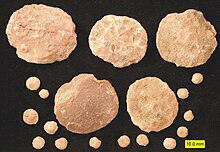Lentil stone
Lens stones are fossils or small stones in the shape of a lens.
Already by the Greek geographer Strabon († after 23 AD) observations of "lenticular stones" (ψήγματα φακοειδῆ) at the pyramids, which were thought to be petrified lenses left behind by previous construction workers, have been handed down . Since there were similar pieces of "porous stone" in his home country, he doubted this theory.
According to Johann Friedrich Blumenbach's book Images of Natural History Objects , it is said to be petrified conchylia , i.e. shell molluscs. According to other sources, fossils also known as penny stones or nummulites are made up of petrified foraminifera .
Myths and legends
In Austria there is a legend entitled “The stone lentils of Guttaring ”, according to which a farmer who, despite admonition, stayed away from an important church visit to sow lentils, was punished by turning his lentils to stone.
According to another Christian legend, the holy missionary Bonifatius is the namesake of the synonyms Pfennigstein and Bonifatiuspfennig , which consist of petrified stems of sea lilies that were either drawn in by the pagan Teutons who did not want to be converted (see also Erkeroder Trochitenkalk # Mystik ) or originated because Boniface cursed as money in a country that offered him violent resistance when he was Christianized and demanded money and goods from him.
According to Johann Nepomuk Sepp ( Altbayerischer Sagenschatz , p. 309) those who went on a pilgrimage to the Maria Eck monastery should bring Maria Eck Pfennige or Eckernpfennige . The reason for this legend are the fossilized nummulites found in the vicinity of the monastery.
More synonyms
- Latin: Lapis numismalis or Lapis nummularius or neo-Latin Lapis lenticularis
- Fruit stone
- Wichtelpfennige , witch money
- Farmer's pennies , devil's money
Individual evidence
- ^ Adelung, Grammatical-Critical Dictionary of High German Dialect, Volume 2. Leipzig 1796, p. 2077.
- ^ Johann Georg Krünitz : Oekonomische Encyklopädie , p. 376, online
- ↑ a b c d e f Hans Lüschen: The names of the stones. The mineral kingdom in the mirror of language . Ott Verlag, Thun and Munich 1968, p. 266, 291-292 .
- ^ Johann Friedrich Blumenbach : Images of natural history objects. (available online from google book search; 40th Phacites Fossilis )
- ↑ sey.at - The stone lenses from Guttaring
- ↑ a b Steine-und-Minerale.de - Bonifatiuspfennig
- ↑ Dr. Schafhäutl: Contributions to a closer knowledge of the Bavarian Prealps. In: Scholarly advertisements of the k. bayer. Academy of Science. Volume 22, No. 89, May 5, 1846, p. 717. ( Online: Bayerische StaatsBibliothek digital; Scan 365 )
- ↑ Lentil stone . In: Jacob Grimm , Wilhelm Grimm : German Dictionary . Hirzel, Leipzig 1854–1961 ( woerterbuchnetz.de , University of Trier).

